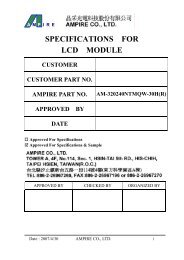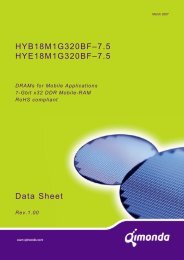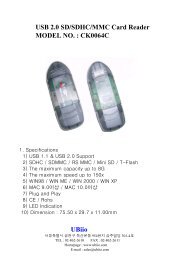Create successful ePaper yourself
Turn your PDF publications into a flip-book with our unique Google optimized e-Paper software.
Internet Data Sheet<br />
HY[B/I]18T256[40/80/16]0B[C/F](L)<br />
256-Mbit Double-Data-Rate-Two SDRAM<br />
Parameter Symbol DDR2–533 Unit Notes 1)2)3)4)5)<br />
Average periodic refresh Interval t REFI — 7.8 μs<br />
Average periodic refresh Interval t REFI — 3.9 μs<br />
15)17)<br />
Auto-Refresh to Active/Auto-Refresh t RFC 75 — ns<br />
16)<br />
command period<br />
Precharge-All (4 banks) command period t RP t RP — ns<br />
Read preamble t RPRE 0.9 1.1 t CK<br />
13)<br />
Read postamble t RPST 0.40 0.60 t CK<br />
13)<br />
Active bank A to Active bank B command t RRD 7.5 — ns<br />
13)17)<br />
period<br />
Active bank A to Active bank B command t RRD 10 — ns<br />
15)21)<br />
period<br />
Internal Read to Precharge command delay t RTP 7.5 — ns<br />
Write preamble t WPRE 0.25 — t CK<br />
Write postamble t WPST 0.40 0.60 t CK<br />
18)<br />
Write recovery time for write without Auto- t WR 15 — ns<br />
Precharge<br />
Internal Write to Read command delay t WTR 7.5 — ns<br />
19)<br />
Exit power down to any valid command t XARD 2 — t CK<br />
20)<br />
(other than NOP or Deselect)<br />
Exit active power-down mode to Read t XARDS 6 – AL — t CK<br />
20)<br />
command (slow exit, lower power)<br />
Exit precharge power-down to any valid t XP 2 — t CK<br />
command (other than NOP or Deselect)<br />
Exit Self-Refresh to non-Read command t XSNR t RFC +10 — ns<br />
Exit Self-Refresh to Read command t XSRD 200 — t CK<br />
Write recovery time for write with Auto-<br />
Precharge<br />
WR t WR /t CK t CK<br />
21)<br />
1) V DDQ = 1.8 V ± 0.1 V; V DD = 1.8 V ±0.1 V.<br />
2) Timing that is not specified is illegal and after such an event, in order to guarantee proper operation, the DRAM must be powered down<br />
and then restarted through the specified initialization sequence before normal operation can continue.<br />
3) Timings are guaranteed with CK/CK differential Slew Rate of 2.0 V/ns. For DQS signals timings are guaranteed with a differential Slew<br />
Rate of 2.0 V/ns in differential strobe mode and a Slew Rate of 1 V/ns in single ended mode. For other Slew Rates see Chapter 8 of this<br />
datasheet.<br />
4) The CK / CK input reference level (for timing reference to CK / CK) is the point at which CK and CK cross. The DQS / DQS, RDQS / RDQS,<br />
input reference level is the crosspoint when in differential strobe mode. The input reference level for signals other than CK/CK, DQS/DQS,<br />
RDQS / RDQS is defined in Chapter 8.3 of this datasheet.<br />
5) Inputs are not recognized as valid until V REF stabilizes. During the period before V REF stabilizes, CKE = 0.2 x V DDQ is recognized as low.<br />
6) The output timing reference voltage level is V TT . See Chapter 8 for the reference load for timing measurements.<br />
7) For each of the terms, if not already an integer, round to the next highest integer. t CK refers to the application clock period. WR refers to<br />
the WR parameter stored in the MR.<br />
8) The clock frequency is allowed to change during self-refresh mode or precharge power-down mode.<br />
9) For timing definition, refer to the Component data sheet.<br />
10) Consists of data pin skew and output pattern effects, and p-channel to n-channel variation of the output drivers as well as output Slew Rate<br />
mis-match between DQS / DQS and associated DQ in any given cycle.<br />
11) MIN (t CL , t CH ) refers to the smaller of the actual clock low time and the actual clock high time as provided to the device (i.e. this value can<br />
be greater than the minimum specification limits for t CL and t CH ).<br />
Min.<br />
Max.<br />
6)<br />
13)14)<br />
<strong>Rev</strong>. <strong>1.11</strong>, 2007-07 55<br />
11172006-LBIU-F1TN



![Internet Data Sheet HYS72T[32/64]xxxHP-[3S/3.7]-A Rev. 1.01 - UBiio](https://img.yumpu.com/50510224/1/184x260/internet-data-sheet-hys72t32-64xxxhp-3s-37-a-rev-101-ubiio.jpg?quality=85)
![Internet Data Sheet HYB18TC256[80/16]0BF Rev. 1.3 - UBiio](https://img.yumpu.com/50510226/1/184x260/internet-data-sheet-hyb18tc25680-160bf-rev-13-ubiio.jpg?quality=85)

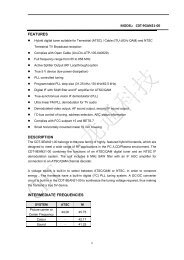
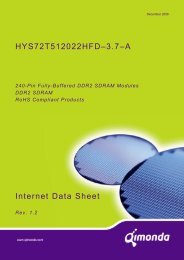

![Internet Data Sheet HY[B/I]39SC128[800/160]FE Rev. 1.1 - UBiio](https://img.yumpu.com/31629373/1/184x260/internet-data-sheet-hyb-i39sc128800-160fe-rev-11-ubiio.jpg?quality=85)
